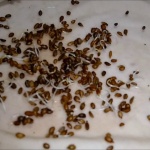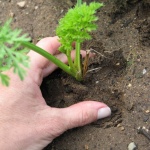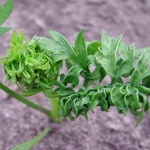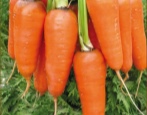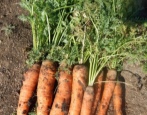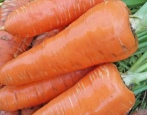
- Authors: Holland
- Name synonyms: Royal Forto, Royal Forto
- Year of approval: 1997
- Appointment: for fresh consumption, for canning, for freezing, for making juice
- Leaf rosette shape: from compact to semi-spreading
- Leaves: medium, green
- Weight, g: 89-108
- The form : cylindrical, blunt tip
- Taste qualities: good ones
- Ripening terms: mid-late
When choosing a carrot variety for planting in a garden bed, it is necessary to take into account how the vegetable crop is adapted to the climatic characteristics of the region, since the yield often depends on this. For the Central region, the medium-late Forto variety will be a suitable variety.
Breeding history
Forto carrots were bred by Dutch breeders of Monsanto Holland B. V. in 1993. 4 years later (in 1997), the vegetable crop was added to the State Register of Admitted to Use. The variety is cultivated in the Central region. You can grow a vegetable both in small garden beds and in farm fields. In recent years, the geography of growing vegetables has expanded significantly - Forto carrots are massively grown in Ukraine, Moldova.
Description of the variety
The Dutch carrot is a powerful rosette with medium-length leaves (30-35 cm). The color of the leaves is emerald green, uniform, and the ends are slightly dissected. The outlet can be semi-spreading or very compact. Carrots belong to the Nantes cultivar. A characteristic feature of the variety is the location of the root crop in the garden bed, which protrudes slightly above the soil surface, which greatly simplifies harvesting.
Characteristics of the appearance of the plant and root crops
Forto carrots grow aligned and flavorful. The average weight of the root crop is 89-108 grams. The length of the vegetable does not exceed 18-20 cm, and the diameter is 4 cm. The shape of the fruit is correct - cylindrical with a blunt "nose". The ripe fruit is evenly covered with a bright orange color. The bark of the carrot is tender and thin, with a smooth and shiny surface, without eyes and lateral filaments.
Dug carrots can be transported over long distances without loss of marketability. It is also worth noting the long-term keeping quality of the variety, subject to storage conditions (+ 2 ... 4 degrees, dry and dark indoors).
Purpose and taste of tubers
Forto is famous for its great taste. The orange flesh has a firm, fleshy, crunchy and juicy texture without fibrillation. The taste is dominated by summer sweetness, harmoniously combined with a pronounced carrot aroma. There is no bitterness in the taste. The core is very thin, without rigidity. Carrot pulp is rich in carotene, sugar, ascorbic and niacin, as well as riboflavin and biotin.
Ripe and selected carrots are recommended to be consumed fresh, added to cold and hot dishes, pickled, frozen, used for canning vegetables, processed in puree and juices, and stored throughout the winter (blanks).
Maturation
The Forto variety is medium late. From the emergence of seedlings to ripe root crops on the ridges, 120-130 days pass. Germination after 12-14 days occurs at a temperature of + 18 ... 20 degrees, but in cooler conditions, the appearance of sprouts slows down. Harvesting fully ripe root crops is carried out in August-September.
Yield
The yield indicators of the variety are high.On average, up to 4.5 kg of crunchy fruits can be dug from 1 m2. Growing a crop on an industrial scale, an average of 312-450 centners of leveled specimens are collected from 1 hectare of plantings.
Growing and care
Carrots are cultivated by seed method. For cultivation, a site is prepared in advance, in which elongated grooves with a depth of 1-1.5 cm are made, where the seeds are immersed. The distance between the rows is about 20 cm. Planting is carried out according to the scheme 15-20x5 cm. Sowing is recommended to be carried out with a stabilized temperature regime. As a rule, this is from April 20 to May 15. The best place to grow is where cucumbers, tomatoes, onions, early potatoes and cabbage used to grow.
Caring for a vegetable crop consists of standard procedures: watering with settled water, fertilizing twice a season, loosening and weeding the soil, thinning plantings (2 times for the entire period), keeping the distance between plants 6-7 cm, preventing viruses and pest infestations.
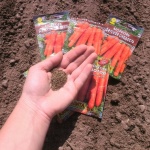
Carrots are one of the most unpretentious crops in terms of growing conditions; they can endure a short drought and a short cold snap. However, to get tasty and large root crops, you should adhere to the basic rules for planting carrots.

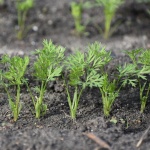
Soil requirements
The vegetable prefers light, nutritious, loose, well-drained soil with low or neutral acidity. The best option for planting will be loam or sandy loam.
Required climatic conditions
The vegetable is planted in a cleaned and sunny area, where it is light and warm. Flat ridges or small hills without heavy and waterlogged soil are ideal. In addition, carrots are susceptible to shade, temperature extremes and excessive moisture.
Disease and pest resistance
The immunity of the variety is moderate, so prophylaxis is indispensable. In addition, fungal diseases can cause violations of the rules of care. The most dangerous pests for Forto carrots are: carrot fly, moth, scoop and nematode, which will help to get rid of special treatments. Plants with a pungent aroma, planted near root crops, can scare off a carrot fly.

Carrots grow in almost any garden. There is an opinion that this culture is very resistant to all kinds of diseases and pests, but this is not the case. Without proper care, carrots become susceptible to all kinds of infections and are affected by harmful insects.


